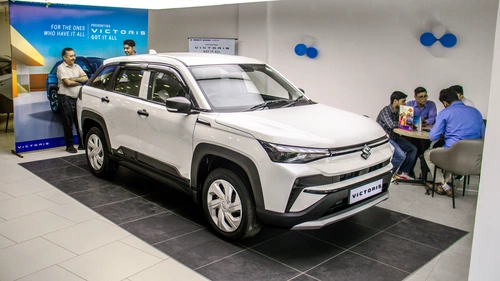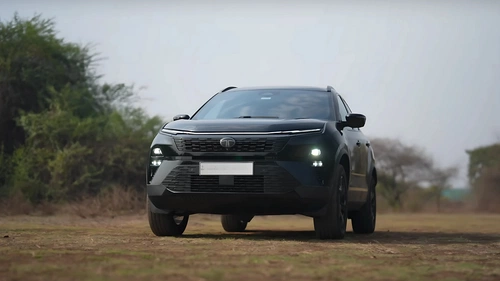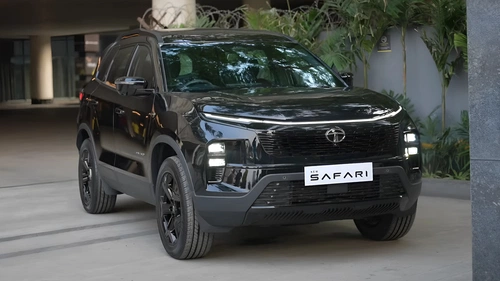






Renault Bigster

The 2026 Renault Bigster is an eagerly anticipated mid-size SUV, expected to be a larger, potentially seven-seater sibling to the new-generation Duster in India. It aims to blend rugged SUV aesthetics with modern features and efficient powertrains, including hybrid options, to compete in a highly contested segment.
Renault Bigster Variants & Prices
Filter By Fuel type & Transmission type| Variant Details | Ex. Showroom Price | |
|---|---|---|
Bigster Bigster New Variant Base Model1299 cc, Manual, Petrol | ₹ 12 Lakh* |
Renault Bigster Key Specs & Features
Pros & Cons of Renault Bigster
Things We Like
- Robust and assertive SUV design with high ground clearance.
- Expected to offer a 7-seater configuration, enhancing practicality.
- Modern and efficient powertrain options, including strong hybrids.
- Feature-rich interior with advanced infotainment system.
- Comprehensive safety suite with 6 airbags and ADAS features.
- Strong ride comfort and capable handling, especially on varied terrains.
Things We Don't Like
- Final pricing and exact specifications for India are yet to be confirmed.
- Faces intense competition in the crowded mid-size SUV segment.
- Renault's service network and perception in India might need strengthening for a premium offering.
- Hybrid technology might initially lead to higher acquisition costs.
Renault Bigster Overview

The 2026 Renault Bigster is set to be a significant addition to Renault's SUV lineup in India, positioned above the upcoming new-generation Duster. Globally known as the Dacia Bigster, its Renault-badged version for markets like India is speculated to be named “Boreal” or retain the “Bigster” moniker. Expected to arrive around June-July 2026, it is a mid-size SUV designed to offer a compelling package that combines rugged design, spacious interiors (potentially with a 7-seater configuration), and a choice of modern, efficient powertrains, including strong hybrid options. Its development on the CMF-B platform, shared with the new Duster, promises a versatile and capable vehicle designed to meet diverse consumer demands.
engine and performance
The 2026 Renault Bigster is expected to offer a range of modern and efficient powertrains, leveraging the CMF-B platform's versatility. For the Indian market, a key engine option is likely to be a 1.3-litre turbocharged flex-fuel engine, capable of producing around 160 bhp and 270 Nm of torque. This engine is expected to be paired with a 6-speed dual-clutch automatic gearbox, offering a balance of performance and efficiency.
In addition to the turbo-petrol, Renault is strongly considering strong-hybrid variants for the Bigster, which could arrive within 6-12 months of the initial petrol launch. These hybrid systems are expected to combine a petrol engine (e.g., a 1.6-litre unit) with electric motors and a battery pack, aiming for enhanced fuel efficiency and the ability to drive in pure-electric mode for a significant portion of city travel. A 4x4 system is also expected to be available, likely for higher variants, enhancing its off-road capabilities. While a naturally aspirated petrol engine and manual transmission options might also be offered, the focus will be on modern, efficient, and refined powertrains.
Ride and Handling
The ride and handling characteristics of the 2026 Renault Bigster are expected to strike a balance between comfort, particularly on varied road surfaces, and confident handling. Built on the versatile CMF-B platform, it will feature a suspension setup designed to effectively absorb road imperfections, providing a pliant and comfortable ride, which is crucial for Indian conditions.
The 220mm ground clearance will be a significant advantage, allowing the Bigster to easily tackle rough roads, unpaved paths, and large speed breakers without concern for underbody scraping. The steering system is anticipated to be well-weighted, offering adequate feedback and precision for both city driving and highway cruising. While it may not be a sporty handler, its overall composure and stability at higher speeds are expected to be good. The availability of a 4x4 system in select variants, along with a multi-position Terrain Control system (with modes like Snow, Mud/Sand, Off-Road, Eco, and Auto), will further enhance its capability and confidence on diverse terrains. Hill Descent Control might also be offered for improved stability on tricky downhill sections.
interior
The interior of the 2026 Renault Bigster is designed to offer a spacious, practical, and modern cabin experience. While adhering to a philosophy of "functional minimalism" in some aspects, it is expected to feature upgraded materials compared to current Renault models in India, with soft-touch elements in key areas and more realistic faux metal accents.
The Bigster is anticipated to offer generous headroom and legroom, particularly in the first and second rows. A key highlight for the Indian market is the strong possibility of a 7-seater configuration, making it a versatile option for larger families. The dashboard design is expected to be contemporary, with a focus on digital displays. Features like dual-zone automatic climate control, a refrigerated center bin, and potentially a premium sound system (e.g., Harman Kardon) could be available in higher variants. The seats are likely to be upholstered in durable fabric or leather-look material with contrast stitching, aiming for both comfort and a premium feel.
Infotainment
The infotainment system in the 2026 Renault Bigster is expected to be a significant leap forward, offering a modern and connected user experience. It will likely feature a large 10.1-inch touchscreen infotainment system seamlessly integrated into the dashboard, possibly flowing into the digital instrument cluster.
This system is anticipated to run on an advanced operating system, potentially Android Automotive, providing intuitive controls for navigation, media, and vehicle settings. Built-in Google Maps for navigation and Google Assistant for voice recognition are strong possibilities. Connectivity will be comprehensive, with wireless Apple CarPlay and Android Auto expected to be standard, allowing for effortless smartphone integration. A 7-inch digital instrument cluster (or larger in higher variants) will provide customizable views of driving data. Other expected features include steering-mounted controls, USB charging ports, and possibly wireless smartphone charging, enhancing convenience and connectivity for all occupants.
exterior
The exterior design of the 2026 Renault Bigster is expected to exude a robust and assertive SUV presence, building on the design language seen in its Dacia counterpart. It will feature a muscular and boxy silhouette, emphasizing its rugged capabilities and commanding road presence. Key design elements are likely to include a wide, assertive front grille, flanked by sleek LED headlights with a distinctive Y-shaped daytime running light (DRL) signature.
The Bigster is anticipated to boast substantial dimensions, with an overall length of approximately 4570mm, a width of around 1812mm (2069mm with mirrors extended), and a height of 1662mm. Its wheelbase is expected to be around 2702mm, contributing to a spacious cabin. A notable feature will be its high ground clearance, estimated to be around 220mm, which is excellent for navigating challenging Indian road conditions. The design will likely incorporate extensive black body cladding, hexagonal wheel arches, and possibly a two-tone finish with a contrasting black roof, enhancing its adventurous appeal. Silver roof rails and integrated turn indicators in the side mirrors are also expected.
safety
Safety is expected to be a key focus for the 2026 Renault Bigster, with the vehicle designed to meet modern safety standards. The Dacia Bigster, its global counterpart, has received a 3-star Euro NCAP safety rating, with strong scores in adult and child occupant protection. The Renault Bigster for India is expected to build on this foundation.
The Bigster is anticipated to come with six airbags as standard, including dual front airbags, side airbags, and curtain airbags, providing comprehensive passive safety. Active safety features will include Anti-lock Braking System (ABS) with Electronic Brakeforce Distribution (EBD), Autonomous Emergency Braking (AEB) for pedestrians, motorcyclists, and other cars, and Speed Assistance. Other crucial safety systems expected are Lane Keep Assist, Driver Fatigue and Distraction Recognition, Blind Spot Warning, and Traffic Sign Recognition. Rear parking sensors and a reverse parking camera will also be standard. While Euro NCAP noted some areas for improvement, such as far-side impact protection, the overall safety package is expected to be robust for its segment.
competition
The 2026 Renault Bigster is set to enter the highly competitive mid-size SUV segment in India, where it will face established players and upcoming models. Its potential 7-seater configuration will place it in direct competition with several popular SUVs.
Key rivals are expected to include the Tata Safari and Hyundai Alcazar, both of which offer 7-seater layouts and a strong market presence. Other significant competitors will be the Mahindra XUV700 and MG Hector Plus, known for their feature-rich interiors and strong performance. Depending on its final pricing and features, it might also compete with the Mahindra Scorpio-N and the upcoming Toyota Rumion (if positioned similarly). Renault will aim to differentiate the Bigster through its rugged design, efficient powertrain options (especially the hybrid), high ground clearance, and a strong value proposition to carve out its niche in this crowded segment.
final verdict
The 2026 Renault Bigster is poised to be a compelling and strategic offering for Renault in the Indian market. By leveraging the new CMF-B platform and offering a larger, potentially 7-seater SUV with modern powertrains, including strong hybrids, it aims to address a significant demand gap. Its rugged exterior, spacious and feature-rich interior, and strong safety package position it as a formidable contender in the mid-size SUV segment.
However, its success will depend on aggressive pricing, the effective localization of parts, and the expansion of Renault's service network to support these new, more complex powertrains. While it promises a versatile and capable package for families and adventurers alike, its ability to truly challenge established rivals will hinge on its overall value proposition and long-term ownership experience. For buyers seeking a robust, spacious, and efficient SUV with a strong road presence, the Bigster could be a very attractive option, marking a new chapter for Renault in India.


















